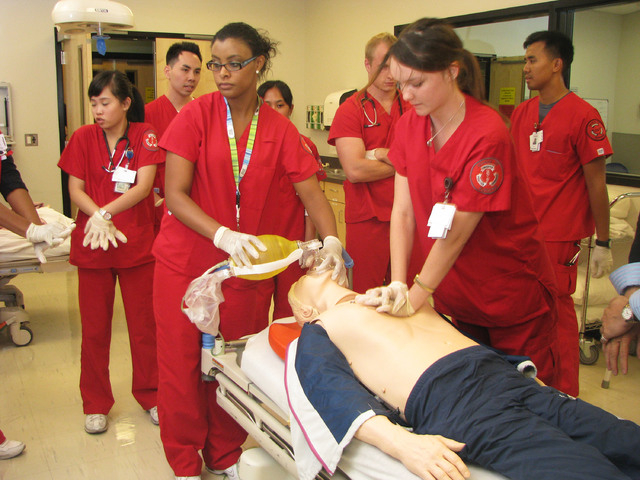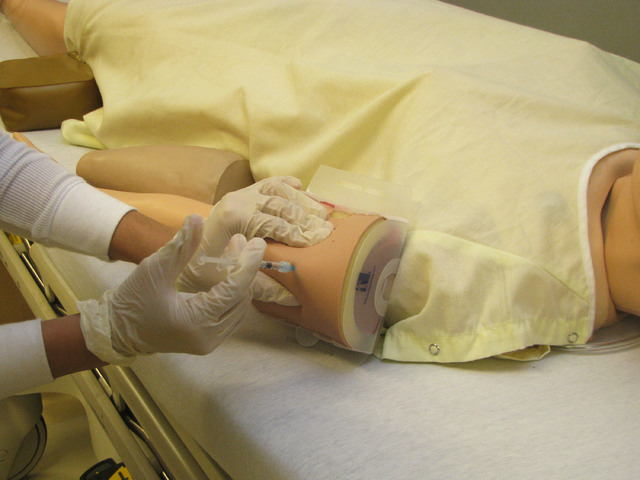Clinical Simulation Center uses high-tech manikins to train medical students




Behind the doors of an unremarkable building in an older part of town, there is a woman who has given birth more than 1,000 times, a man who regularly fakes post-traumatic stress disorder and a storage room with stacks of babies. It’s just another day at the office for the staff of the Clinical Simulation Center of Las Vegas.
The center, 1001 Shadow Lane, trains nursing and medical students in the finer points of giving injections, performing surgery and attending childbirth. Most of the practice patients — the pile of babies in storage and “Noelle,” the remarkable multi-birth mother — are remotely operated manikins (mannequins used for educational purposes). From a darkened control room, instructors can make them emulate a variety of symptoms, and the more complicated manikins have some involuntary function. For example, while nursing students practiced CPR on one manikin, in a nearby hospital bed another’s chest rose and fell with simulated breathing, and occasionally, it blinked.
“We have high-, low- and mid-fidelity manikins,” said Jackie Kinsey, director of operations for the center. “The high-fidelity manikins are very realistic and run about $65,000 apiece. They can sweat, sneeze, cry, their mouth can turn blue to represent being cyanotic (low oxygen level in the blood) and do a lot of other things. From the computer that we control them with, we can create different bowel, heart and lung sounds.”
The control area also has a microphone, so instructors can speak as the patient. Students can ask about symptoms and get a real-time reply. The entire process is video-recorded so students and instructors can discuss what was done correctly and incorrectly and could be improved.
Before the creation of this technology, students had to practice injections on each other. Now students practice on an artificial arm with artificial blood flowing through it.
“We have full arms, and we have small sections of arms, which are used to save wear and tear on the full arms,” said Lysander Abadia, the center’s simulation and skills technician. “For injections, we often place one of the small sections near the full arm, so the student knows where the injection goes.”
The skin on the simulated body parts can be pierced by needles only so many times before it becomes unusable, but many of the parts come with replaceable skin.
The center operates like a school aided by a film crew, with special effects, props and actors. Manikins have wigs, bad teeth, glasses, tattoo sleeves or other items added to increase the simulated reality and provide variety for the students.
“Sometimes we’ll do something like put a bottle of alcohol in the bed, to simulate an alcoholic patient trying to hide it,” Kinsey said. “We can replicate scenarios they might run across in day-to-day operations at a real hospital, like seizures.”
The 31,000-square-foot center has classrooms, offices, skill labs, a 12-bed hospital ward, a standardized patient hall and five high-fidelity rooms, including three adult, one labor and delivery room and a pediatric room. A storage room houses manikins when they aren’t in use, along with various faux drugs, simulated body parts and fluids. The center has a recipe book for artificial blood, bodily waste and other fluids. There are also artificial scars and wounds.
The manikins are remarkable in their ability to replicate human biology, but for psychological issues, the center uses a more complex simulator: human actors.
“Our standardized patient coordinator has a database of actors,” Kinsey said. “For instance, if she needs a Caucasian female between 18 and 20, she’ll check it and find an actor who’s available for rehearsals and the event.”
The center also has a handful of specialized actors who have practiced how to emulate specific psychological issues, including one who portrays a man with post-traumatic stress disorder and reacts differently depending on how the students handle the situation.
Some of the simulations the center handles would be impossible to replicate on fellow students or actors, such as laparoscopic surgery. Students practice that on a manikin torso fitted with two small incisions and a camera. They use long, thin tools to probe and manipulate objects inside the body cavity using only the image from the camera.
The Clinical Simulation Center is a collaborative venture between the UNLV School of Nursing, the School of Nursing at Nevada State College and the University of Nevada School of Medicine. The arrangement allows the schools to pool their efforts and provide more elaborate and expensive simulations than either school might be able to afford separately.
For more information, visit csclv.nevada.edu/csclv.
Contact East Valley View reporter F. Andrew Taylor at ataylor@viewnews.com or 702-380-4532.


















